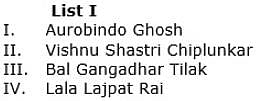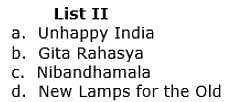MH SET Paper 2 Mock Test - 1 (History) - MAHA TET MCQ
30 Questions MCQ Test - MH SET Paper 2 Mock Test - 1 (History)
Change from informal to formal empires was driven by the idea of:
Consider the following statements
1) The First Session of the Indian National Congress was held in Calcutta.
2) The Second Session of the Indian National Congress was held under the presidentship of Dadabhai Naoroji.
3) Both Indian National Congress and Muslim League held their sessions at Lucknow in 1916 and concluded the Lucknow Pact.
Which of the statement(s) given above is/are correct?
| 1 Crore+ students have signed up on EduRev. Have you? Download the App |
As per the Dual government the Company got the Diwani rights. For exercising the functions company appointed two deputies Diwans, one for Bengal and one for Bihar. Who was appointed as deputy diwan for Bihar?
Given below are two statements, One is labelled as Assertion (A) and the other is labelled as Reason (R) :
Assertion (A):- Descriptive research includes surveys and fact-finding enquiries of different kinds.
Reasons (R) :- The main characteristic of this method is that the researcher has full control over the variables.
In the light of the above statements, choose the correct answer from the options given below
Raj Kumar Shukla was a resident of which of the following villages?
Consider the following options.
1. The fifth report submitted to the British Parliament in 1813 AD.
2. Jotedars were quite powerful.
3. Santhals were a great danger to Paharis.
4. No Zamindari was auctioned in Bengal.
With reference to the Khaksars, consider the following statements.
1) It was aimed at freeing India from the rule of the British Empire and establish a Hindu-Muslim government in India.
2) They were the Khaki uniform wearing quasi-military organisation of the Muslims.
3) They carried spades with them.
Choose the incorrect statements.
Vallabhbhai Patel got the title of Sardar due to leadership and success in which one of the following movements?
Consider the following statements
1). Wood's Despatch laid emphasis on higher education and neglected primary education
2). Macaulayian system was outcome of Orinetalist-Anglicist controversy
Which of the above statement(s) is/are incorrect?
Which of the following acts was passed after the agitation of the Moderates of INC?
Consider the following statements about the scripts used in the Ashokan inscriptions :
1. Kharosthi script was written from left to right.
2. Brahmi script was written from right to left.
3. Greeks changed their horizontal writing direction from right-to-left to left-to-right for better efficiency.
Which of the statements given above is/are correct?
With reference to the Sree Padmanabhaswamy Temple, consider the following statements:
1. According to Historians, the temple dates back to the 8th century but the present structure was built in the 18th century by the then Travancore Maharaja Marthanda Varma.
2. The temple was initially made of wood but later it was constructed with granite.
3. The temple is built in the unique Chera style of architecture.
Which of the above statement is/are correct?
Assertion(A): The humanists of the Renaissance period believed that classical antiquity constituted a reservoir of excellence-literacy, intellectual, artistic and moral.
Reason(R): The vernacular translation of scriptures during the Renaissance hastened the process of secularisation of society.
In the context of the above statements which of the following is correct?
Choose the correct statements.
1) In 1858 Lord Canning sent forth the royal proclamation in a grand Darbar at Delhi.
2) It was then proclaimed that all treaties and engagements of East India Company with princely states would be maintained and honoured.
3) The document was called “Magnacarta of the People of India”.
Consider the following statements:
Assertion(A):- In sharp contrast to Egypt and Mesopotamia, we do not find evidences of temple at the Harappan sites.
Reason(R):- However, indications of the priestly class being one of the ruling classes is quite evident.
As a Gandhian, if you were to practise the idea of 'Satyagraha', you would emphasise upon :
A. Winning battles by being aggressive.
B. Appealing to the conscience of the oppressor.
C. Resist passively and engage with intense activity.
D. The power of truth and the need to search for the truth by seeking vengeance.
Consider the following statements about the Indian Council of Historical Research:
1. The Indian Council of Historical Research (ICHR) was established under the promulgation of the Societies Registration Act in 1972.
2. It is an autonomous organization, which draws funds from the University Grants Commission.
3. It does not provide fellowships and financial assistance to scholars and historians for their research.
Which of the above-given statements are correct?
With reference to the history of philosophical thought in India, consider the following statements regarding Sankhya school :
1. Sankhya does not accept the theory of rebirth or transmigration of soul.
2. Sankhya holds that it is the self – knowledge the leads to liberation and not any exterior influence or agent.
Which of the statements given above is / are correct?
As per the Government of India Act of 1919, the appointment of the Simon Commission was scheduled in which year?
Match List I with List II, and select the correct answer by using the codes given below the lists:
List I
I. Jawaharlal Nehru
II. Sardar Patel
III. J.B. Kripalani
IV. Dr. Rajendra Prasad
List II
a. States Committee
b. Provincial Constitution Committee
c. Steering Committee
d. Fundamental Rights Sub-Committee
Codes:
When was the Panchsheel formally enunciated?
Given below are two statements, one labelled as Assertion (A) and the other labelled as Reason (R).
Assertion (A) : Despite its name, the Hindu Code Bill was to apply to Sikhs, Buddhists, and Jains as well as Hindu castes and sects.
Reason (R) : After independence, among those favouring a common civil code were the Prime Minister Jawaharlal Nehru and the law minister, Dr. B.R. Ambedkar.
In the context of these statements, which of the following is correct ?
French East India Company was constructed during the reign of-
A Buddha can be born only as a Brahmin or a Kshatriya and not “in a low family such as that of a Chandala or of a basket-maker or of a chariot-maker or of a Pukkasa.” The given statement is taken from:



















